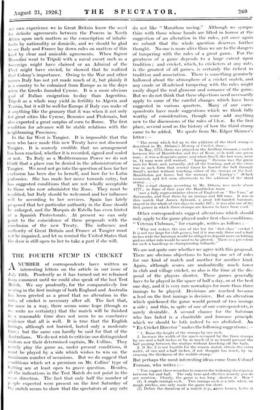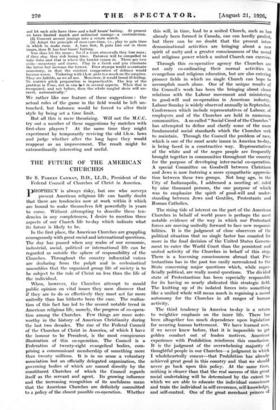THE FOURTH STUMP IN CRICKET
ANUMBER of correspondents have written us interesting letters on the article in our issue of July 24th. Prudently as it has turned out we refrained from comment until we could also speak of the last Test Match. We say prudently, for the comparatively low se.)ring in the first innings of both England and Australia has been greeted as a proof that no alteration in the rule of cricket is necessary after all. The fact that, for once in a way, there seems some hope (though as we write no certainty) that the match will be finished in a reasonable time does not seem to us conclusive evidence that all is well. It is true that the English innings, although not hurried, lasted only a moderate lime; but the same can hardly be said for that of the Australians. We do not wish to criticize our distinguished visitors nor their determined captain, Mr. Collins. They tiv.Tely play the game as, under present conditions, it must be played by a side which wishes to win on the maximum number of occasions. But we do suggest that :.mditions which set a premium on Mr. Collins' type of hitting are at least open to grave question. Besides, the indications in the Test Match do not point in the .ie direction. The fact that only half the number of 1, plc expected were present on the first Saturday of fly.: match seems to show that the spectators at any rate do not like " Marathon racing." Although we sympa- thize with those whose hands are lifted in horror at the suggestion of an alteration in the rules, yet once again we submit that the whole question deserves further thought. No one is more alive than we are to the dangers of tampering with the rules of a great game. For the greatness of a game depends to a large extent upon tradition ; and cricket, which, to cricketers at any rate, is the greatest of all games, is certainly the richest in tradition and association. There is something genuinely hallowed about the atmosphere of a cricket match, and any crude or ill-advised tampering with the rules might easily dispel the real glamour and romance of the game. But we do not think that these objections need necessarily apply to some of the careful changes which have been suggested in various quarters. Many of our corre- spondents have made suggestions which we think fully worthy of consideration, though none add anything new to the discussions of the rules of I.b.w. In t he Iirst place, several send us the history of how the third st ump came to be added. We quote from Mr. Edgar Skinner's letter :— " The event which lod up to the addition of the third stump is described in Mr. Altham's History of Cricket, thus
In May, 1775, there was played on the Art illery :round. a match between five of Hambletion and five of Kent. 0..!•it wit h one given man it was a desperate ga , and when Siiii II. he last man, went in, 14 runs wore still wanted " Lumpy " ;;Icventi was the givou man for Kent, and, naturally, did all the ilOW hog, and at the crisis was in such form that several times he bowled the bull through Small's wicket without touching either of the stumps or the bail. Hamblodon got home, but the memory of " Lumpy's " ill-luck remained, and led soon afterwards to the addition of the third stump . . The antual change, according to Mr. Althann, was made about 1777; in Juno of that year the Hamblodon team met a fully representative eleven of England on " The V• ," at Sevenoaks. and beat them by an innings and 168 runs. It was in this match that James Aylward, a great left-handed batsman. stayed in the whole of two days to make 167; it was also one of the first games in which throe stumps aro known to have boon used.' "
Other correspondents suggest alterations which should only apply to the game played under first-class conditions. " Veteran Clubman," for example, writes as follows :
"Why not reduce the size of the bat for first-class' cricket ? It is not too large for club games, but if it was only throe and a-haii inches wide the batsman would be obliged to depend more on hitting and no other rule would be need to be altered. There is it precedent for such a handicap in championship billiards."
We are not quite sure whether we agree with this proposal. There are obvious objections to having one set of rules for one kind of match and another for another kind. Again, although scores arc undoubtedly much lower in club and village cricket, so also is the time at the dis- posal of the players shorter. These games generally have to be played in the space of half a day, or at t he best one day, and it is very rare nowadays for more than three innings to be played. Decisions arc reached because a lead on the first innings is decisive. Bt an alteration which quickened the game would permit of two innings a side ; and this, in spite of one of our correspondents, is surely desirable. A second chance for the batsman who has failed is a charitable and humane principle which we should be loth indeed to see abolished. An "Ex-Cricket Director" makes the following suggestions :— "I. Raise the height of the stumps by one inch.
2. Increase the width of the space occupied by the three stumps by one and a-half inches or by so much of it as would prevent the ball passing between the stumps without knocking off the bails.
3. If No. 2 is not feasible for the reason stated, obtain the extra width, of one and a-half inches. if not thought too much, by in. creasing the thickness of the middle-stump."
But perhaps the most interesting ideas come from Colonel Forman, who writes :-- " You suggest throe remedies to remove the widening diseropemey between bat and ball. The only true and effective remedy you do not mention. Clearly, the game is too long—shorten it. How ?
(1) A single innings each. Two innings each is a relic when, on rough pitches, ono only made the game too short.
(2) Define the duration of a match (e.g., s-Jvon hours), halve it
rod let each side have three and a-half hours' batting. At present we have limited match and unlimited innings—a contradiction.
(3) Convert second innings into a return match. (4) Adopt the principle of runs-cum-time, i.e., play to gain time in which to make runs. A. bats lust, B. puts him out in three hours, then B. has four hours' batting. You thus hit the mean; for if a team stonewalls they lose runs ; if they slog, they risk losing time. Batsmen will be compelled to take risks and that is where the bowler comes in. There are two evils—monotony and draws. Play to a finish and you eliminate the latter but increase the former. Four stumps would accentuate monotony, in that the existent exaggeration of defence would become worse. Tinkering with 1.b.w. puts tco much on the umpires. They are fallible, as we all are. Moreover, it would breed ill-feeling. To restrict pitch preparation is impracticable. The key of the problem is Time, not in one tint in several aspects. When that is recognized, and not before, then the whole tangled skein will un- ravel, automatically."
We rather like one feature of these suggestions : the actual rules of the game in the field would be left un- touched, but batsmen would be forced to alter their style by being set a time limit.
But all this is mere theorizing. Will not the M.C.C. try out a number of these suggestions by matches with first-class players ? At the same time they might experiment by temporarily reviving the old 1.b.w. laws and judge whether after the long lapse they would reappear as an improvement. The result might be extraordinarily interesting and useful.



































 Previous page
Previous page